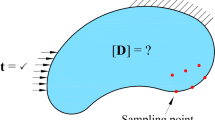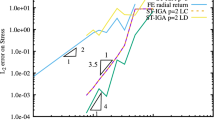Abstract
Without employing ad hoc stress assumptions, the decomposed form of thermoelastic plates for an extensional deformation is proposed on the basis of thermoelasticity theory, and the corresponding decomposition theorem is in extenso presented for the first time. It is shown that the stress state of thermoelastic plates with traction free faces can be uniquely decomposed into four parts: the plane-stress (P-S) state, the shear state, the Papkovich-Fadle (P-F) state, and the thermal state. In the proof course of the decomposition theorem, some basic mathematical methods are used only, so the proof is more convenient for being understood. Due to the corresponding relations of the P-S state and the biharmonic equation, of the shear state and the shear equation, and of the P-F state and the transcendental equation, this work practically proves the equivalence between the decomposition theorem and the refined theory of isothermal plates with free faces. More importantly, the thermal state is in agreement with the Solution P.
Similar content being viewed by others
References
Barber J.R.: Elasticity, 2nd edn. Kluwer, Dordrecht (2002)
Fadle J.: Die Selbstspannungs-Eigenwertfunktionen der quadratischen Scheibe. Ing. Arch. 11, 125–148 (1941)
Boley B.A., Weiner J.H.: Theory of Thermal Stresses. Wiley, New York (1960)
Noda N., Hetnarski R., Tanigawa Y.: Thermal Stresses, 2nd edn. Taylor & Francis, London (2002)
Schiavone P., Tait R.J.: Thermal effects in Mindlin-type plates. Quart. J. Mech. Appl. Math. 46, 27–39 (1993)
Rivera J.E.M., Shibata Y.: A linear thermoelastic plate equation with Dirichlet boundary condition. Math. Meth. Appl. Sci. 20, 915–932 (1997)
Mindlin R.D.: Influence of rotatory inertia and shear on flexural motions of isotropic, elastic plates. ASME J. Appl. Mech. 18, 31–38 (1951)
Reissner E.: The effect of transverse shear deformation on the bending of elastic plates. ASME J. Appl. Mech. 12, 69–77 (1945)
von Kromm, A.: Verallgemeinerte Theorie der Plattenstatik. Ingenieur-Archiv Band XXI, 4. Heft, pp. 266–286 (1953)
Hencky H.: Über die Berücksichtigung der Schubverzerrung in ebenen Platten. Ing. Arch. 16, 72–76 (1947)
Kirchhoff G.R.: Über das Gleichgewicht und die Bewegung einer elastischen Scheibe. J. Reine Angew. Math. (Crelle) 40, 51–58 (1850)
Cheng S.: Elasticity theory of plates and a refined theory. ASME J. Appl. Mech. 46, 644–650 (1979)
Gregory R.D.: The general form of the three-dimensional elastic field inside an isotropic plate with free faces. J. Elast. 28, 1–28 (1992)
Wang M.Z., Zhao B.S.: The decomposed form of the three-dimensional elastic plate. Acta. Mech. 166, 207–216 (2003)
Zhao B.S., Wang M.Z.: The equivalence of the refined theory and the decomposed theorem of an elastic plate. Appl. Math. Mech. 26, 486–494 (2005)
Gao Y., Zhao B.S.: The refined theory of thermoelastic rectangular plates. J. Therm. Stress. 30, 505–520 (2007)
Gao Y., Zhao B.S.: The refined theory of thermoelastic plane problems. J. Therm. Stress. 30, 1233–1248 (2007)
Piltner R.: The derivation of a thick and thin plate formulation without ad hoc assumptions. J. Elast. 29, 133–173 (1992)
Piltner R.: The use of complex valued functions for the solution of three-dimensional elasticity problems. J. Elast. 18, 191–225 (1987)
Gao Y., Zhao B.S.: A refined theory of elastic thick plates for extensional deformation. Arch. Appl. Mech. 79, 5–18 (2009)
Love, A.E.H.: A Treatise on the Mathematical Theory of Elasticity, 4th edn. Dover, New York, p. 467 (1944)
Eubanks R.A., Sternberg E.: On the completeness of the Boussinesq-Papkovich stress functions. J. Ration. Mech. Anal 5, 735–746 (1956)
Lur’e A.I.: Three-Dimensional Problems of the Theory of Elasticity. Interscience, New York (1964)
Gregory R.D.: The semi-infinite strip x ≥ 0,−1 ≤ y ≤ 1; completeness of the Papkovich-Fadle eigenfunctions when \({\phi _{xx}(0, y), \phi _{yy} (0, y)}\) are prescribed. J. Elast. 10, 57–80 (1980)
Gregory R.D.: The traction boundary value problems for the elastostatic semi-infinite strip; existence of solution, and completeness of the Papkovich-Fadle eigenfunctions. J. Elast. 10, 295–327 (1980)
Author information
Authors and Affiliations
Corresponding author
Rights and permissions
About this article
Cite this article
Gao, Y., Zhao, BS. & Wang, MZ. Thermoelasticity theory and the decomposed form of thick plates for extensional deformation. Acta Mech 223, 755–764 (2012). https://doi.org/10.1007/s00707-011-0589-5
Received:
Revised:
Published:
Issue Date:
DOI: https://doi.org/10.1007/s00707-011-0589-5




